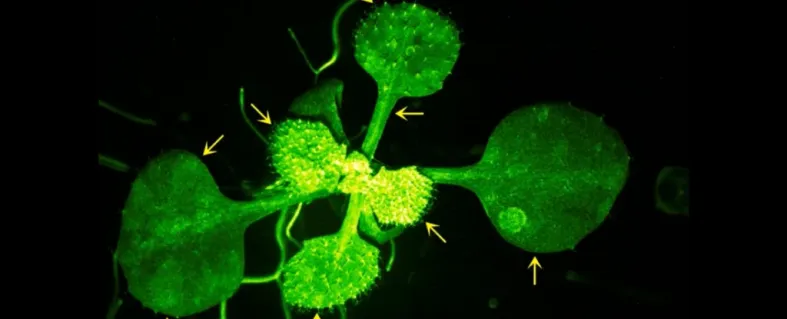Plants are surrounded by an invisible atmosphere of volatile compounds with which they communicate and protect themselves. Like odors, these compounds deter herbivores and signal nearby plants about a potential threat.
Plant defense signals were discovered in the early 1980s and are known in more than 80 species. Recently, Japanese researchers applied real-time imaging techniques to reveal how plants perceive and respond to these airborne “alarm signals.” This was an important discovery because scientists knew about the transmission of signals but did not understand how plants receive them.
In a new study, molecular biologists Yuri Aratani and Takuya Uemura of Saitama University developed a pump to transport volatile compounds released by damaged plants when attacked by insects. Using a fluorescent microscope, they observed how undamaged Arabidopsis plants responded to signals from their damaged neighbors under attack by Spodoptera litura caterpillars.
To accurately monitor calcium signals, researchers used genetically modified plants with biosensors that glow green when calcium ions are detected. These signals also serve as communication tools in human cells.
In their experiments, the researchers observed how plants responded to volatile compounds released from damaged plants within seconds of injury. Although these compounds were supplied through a special pump and not under natural conditions, this allowed us to analyze their effects in detail.
In a video shot by the team, robust plants can be seen receiving alarm signals from their neighbors and responding with flashes of calcium spread across the leaves.
The compounds Z-3-HAL and E-2-HAL were found to induce calcium signals in Arabidopsis plants. The researchers also created plants with fluorescent sensors in different cells to determine which cell types were the first to respond to these signals.
Arabidopsis. (Aratani et al. Nature Communication 2023)
Guard cells on the surface of leaves form stomata, which act as plants’ “nostrils.” Mesophyll cells are found inside the leaves and epidermal cells form the outer layer. The signal first enters the guard cells and is then transmitted to the mesophyll cells. Pretreatment of plants with a phytohormone that closes stomata significantly reduces the calcium signal, confirming the importance of stomata as the main “sensory gate” for signal perception.
“We have finally unraveled the complex story of when, where and how plants respond to aerial ‘warning messages’ from their endangered neighbors,” explained senior study author Masatsugu Toyota of Saitama University.
“This invisible communication network plays an important role in quickly protecting neighboring facilities from potential threats.”
These studies by Japanese scientists shed light on the complex communication system between plants and reveal the ability of plants to respond quickly and effectively to danger. Further study of such signals may be the key to more sustainable agriculture, where natural defense mechanisms would reduce pesticide use. This will not only help reduce the impact on the ecosystem, but also support the development of ecological agriculture.
This breakthrough in understanding the “language” of plants opens new perspectives for research and practical application of knowledge in the field of biology. Thanks to these efforts, scientists can create effective strategies to protect plants from pests by using their natural ability to exchange warning signals. This approach could significantly increase productivity and help preserve our planet’s biodiversity.
The research of Yuri Aratani, Takuya Uemura, and their colleagues gives hope that in the future we will be able to better understand and protect the environment by using the unique natural abilities of plants. Source
Source: Port Altele
